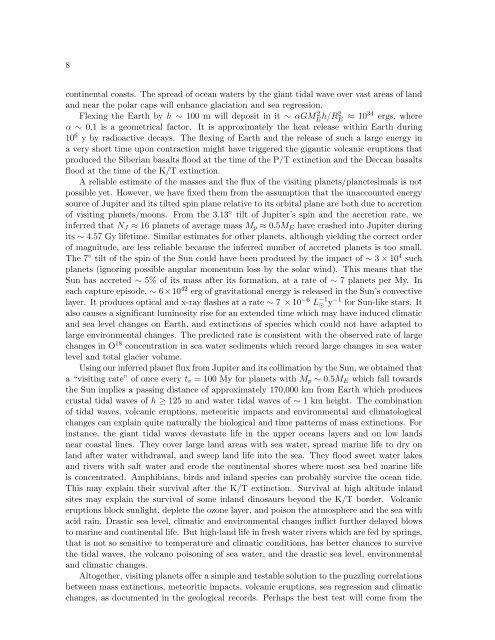Proc. Neutrino Astrophysics - MPP Theory Group
Proc. Neutrino Astrophysics - MPP Theory Group
Proc. Neutrino Astrophysics - MPP Theory Group
You also want an ePaper? Increase the reach of your titles
YUMPU automatically turns print PDFs into web optimized ePapers that Google loves.
8<br />
continental coasts. The spread of ocean waters by the giant tidal wave over vast areas of land<br />
and near the polar caps will enhance glaciation and sea regression.<br />
Flexing the Earth by h ∼ 100 m will deposit in it ∼ αGM2 Eh/R2 E ≈ 1034 ergs, where<br />
α ∼ 0.1 is a geometrical factor. It is approximately the heat release within Earth during<br />
106 y by radioactive decays. The flexing of Earth and the release of such a large energy in<br />
a very short time upon contraction might have triggered the gigantic volcanic eruptions that<br />
produced the Siberian basalts flood at the time of the P/T extinction and the Deccan basalts<br />
flood at the time of the K/T extinction.<br />
A reliable estimate of the masses and the flux of the visiting planets/planetesimals is not<br />
possible yet. However, we have fixed them from the assumption that the unaccounted energy<br />
source of Jupiter and its tilted spin plane relative to its orbital plane are both due to accretion<br />
of visiting planets/moons. From the 3.13◦ tilt of Jupiter’s spin and the accretion rate, we<br />
inferred that NJ ≈ 16 planets of average mass Mp ≈ 0.5ME have crashed into Jupiter during<br />
its ∼ 4.57 Gy lifetime. Similar estimates for other planets, although yielding the correct order<br />
of magnitude, are less reliable because the inferred number of accreted planets is too small.<br />
The 7◦ tilt of the spin of the Sun could have been produced by the impact of ∼ 3 × 104 such<br />
planets (ignoring possible angular momentum loss by the solar wind). This means that the<br />
Sun has accreted ∼ 5% of its mass after its formation, at a rate of ∼ 7 planets per My. In<br />
each capture episode, ∼ 6×1042 erg of gravitational energy is released in the Sun’s convective<br />
layer. It produces optical and x-ray flashes at a rate ∼ 7 ×10−6 L −1<br />
⊙ y−1 for Sun-like stars. It<br />
also causes a significant luminosity rise for an extended time which may have induced climatic<br />
and sea level changes on Earth, and extinctions of species which could not have adapted to<br />
large environmental changes. The predicted rate is consistent with the observed rate of large<br />
changes in O18 concentration in sea water sediments which record large changes in sea water<br />
level and total glacier volume.<br />
Using our inferred planet flux from Jupiter and its collimation by the Sun, we obtained that<br />
a “visiting rate” of once every tv = 100 My for planets with Mp ∼ 0.5ME which fall towards<br />
the Sun implies a passing distance of approximately 170,000 km from Earth which produces<br />
crustal tidal waves of h ≥ 125 m and water tidal waves of ∼ 1 km height. The combination<br />
of tidal waves, volcanic eruptions, meteoritic impacts and environmental and climatological<br />
changes can explain quite naturally the biological and time patterns of mass extinctions. For<br />
instance, the giant tidal waves devastate life in the upper oceans layers and on low lands<br />
near coastal lines. They cover large land areas with sea water, spread marine life to dry on<br />
land after water withdrawal, and sweep land life into the sea. They flood sweet water lakes<br />
and rivers with salt water and erode the continental shores where most sea bed marine life<br />
is concentrated. Amphibians, birds and inland species can probably survive the ocean tide.<br />
This may explain their survival after the K/T extinction. Survival at high altitude inland<br />
sites may explain the survival of some inland dinosaurs beyond the K/T border. Volcanic<br />
eruptions block sunlight, deplete the ozone layer, and poison the atmosphere and the sea with<br />
acid rain. Drastic sea level, climatic and environmental changes inflict further delayed blows<br />
to marine and continental life. But high-land life in fresh water rivers which are fed by springs,<br />
that is not so sensitive to temperature and climatic conditions, has better chances to survive<br />
the tidal waves, the volcano poisoning of sea water, and the drastic sea level, environmental<br />
and climatic changes.<br />
Altogether, visiting planets offer a simple and testable solution to the puzzling correlations<br />
between mass extinctions, meteoritic impacts, volcanic eruptions, sea regression and climatic<br />
changes, as documented in the geological records. Perhaps the best test will come from the













